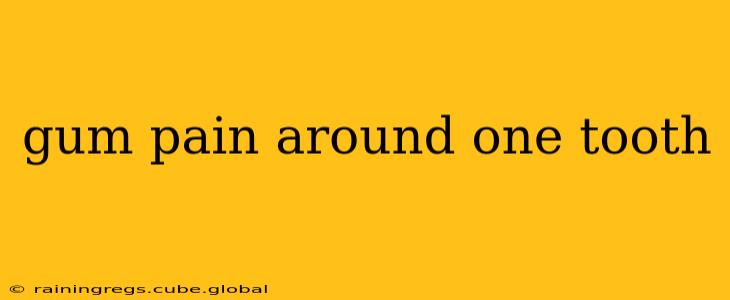Experiencing gum pain localized around a single tooth can be alarming, but understanding the potential causes can help alleviate anxiety and guide you towards appropriate treatment. This pain can range from mild discomfort to severe throbbing, and its origin can be surprisingly varied. This comprehensive guide explores the common culprits behind localized gum pain, offering insights into diagnosis and effective management strategies.
What Causes Gum Pain Around One Tooth?
Gum pain isolated to one tooth often stems from issues directly affecting that specific tooth or its surrounding gum tissue. Several factors can contribute:
-
Gum Disease (Gingivitis or Periodontitis): Inflammation of the gums (gingivitis) is the most common cause. If left untreated, it can progress to periodontitis, a more severe form involving bone and tissue loss. Localized gum disease might manifest as pain around just one tooth, especially if there's significant plaque buildup or infection in that area.
-
Dental Abscess: A painful pus-filled pocket (abscess) can form at the root of a tooth or within the gums. This is typically accompanied by intense throbbing pain and swelling. Bacteria are the primary cause, often originating from a deep cavity or damaged tooth.
-
Impacted Tooth: A partially erupted or impacted tooth (like a wisdom tooth) can irritate the surrounding gums, leading to pain and inflammation. The pressure from the impacted tooth against the gum tissue causes discomfort and can potentially lead to infection.
-
Tooth Decay (Cavities): While cavities primarily affect the tooth itself, advanced decay can reach the pulp (the inner part of the tooth), leading to infection and inflammation that spreads to the surrounding gums, causing pain.
-
Trauma or Injury: A blow or injury to the tooth or gums can trigger localized inflammation and pain. This could be from biting down on something hard or experiencing a sports-related injury.
-
Periapical Abscess: This type of abscess forms at the tip of the root of a tooth and can cause significant pain radiating to the surrounding gums.
-
Other Factors: Less common causes include certain medications, allergies to dental materials, or even sinus infections (which can sometimes refer pain to the upper teeth and gums).
What Are the Symptoms of Gum Pain Around One Tooth?
Symptoms accompanying gum pain around a single tooth can help pinpoint the underlying problem. These include:
- Sharp or throbbing pain: The intensity varies depending on the cause.
- Swelling and redness: Inflammation is a key indicator of infection or irritation.
- Sensitivity to heat or cold: This suggests potential tooth decay or nerve involvement.
- Bleeding gums: Especially noticeable when brushing or flossing.
- Pus formation: A clear sign of an abscess.
- Difficulty chewing: Pain can make it uncomfortable to bite or chew on the affected side.
- Loose tooth: In advanced cases of gum disease.
- Bad breath: Often associated with infections.
How Is Gum Pain Around One Tooth Diagnosed?
A dentist will conduct a thorough examination to diagnose the cause of your gum pain. This usually involves:
- Visual inspection: Checking for swelling, redness, and signs of infection.
- X-rays: To detect cavities, abscesses, or impacted teeth.
- Probing: Measuring the depth of gum pockets to assess the extent of gum disease.
- Palpation: Feeling the area around the tooth to check for tenderness and swelling.
How Is Gum Pain Around One Tooth Treated?
Treatment depends on the underlying cause. Options include:
- Professional cleaning: For gingivitis, a thorough cleaning by a dental hygienist can remove plaque and tartar, resolving the inflammation.
- Antibiotics: For infections like abscesses, antibiotics are often prescribed to fight the bacteria.
- Root canal: If decay has reached the pulp, a root canal might be necessary to save the tooth.
- Extraction: In some cases, particularly with severely damaged or infected teeth, extraction may be the only option.
- Scaling and root planing: For periodontitis, this procedure removes plaque and tartar from below the gum line.
- Surgical intervention: May be needed for impacted teeth or advanced gum disease.
- Pain relief medication: Over-the-counter pain relievers like ibuprofen or acetaminophen can help manage pain and inflammation.
How Can I Prevent Gum Pain Around One Tooth?
Practicing good oral hygiene is crucial for preventing gum pain. This includes:
- Brushing twice daily: Using fluoride toothpaste and a soft-bristled brush.
- Flossing daily: To remove plaque and food particles from between teeth.
- Regular dental checkups: At least twice a year for professional cleaning and examination.
- Maintaining a healthy diet: Limit sugary and acidic foods and drinks.
Is Gum Pain Around One Tooth an Emergency?
Severe pain, swelling, or pus formation warrants immediate dental attention. Don't hesitate to contact your dentist if you experience these symptoms. Early intervention is key to preventing complications.
This information is for general knowledge and does not constitute medical advice. Always consult a dentist for diagnosis and treatment of gum pain.
